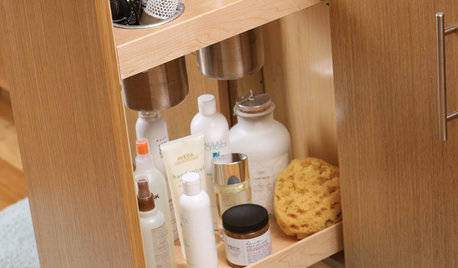Trying A Rooing Gel
dieseler
15 years ago
Related Stories

BATHROOM DESIGNPut the Kibosh on Hair Dryer Chaos
Fed up with knocked-over blowers and tangled cords? Try these tactics for keeping hair dryers and other styling tools under control
Full Story
HOUZZ TOURSMy Houzz: Relaxing Retreat on a River in Maine
Windows wrap a couple's light and airy weekend home to provide stunning views of the Piscataqua River
Full Story
HOUZZ TOURSMy Houzz: White Interiors Brighten a Dutch Cottage
Snowy finishes and minimal accessories give a compact 2-bedroom home for a family of 5 a more open feel
Full Story
HOME TECHIce Cubes Are Obsolete! New Technology Is Way Cooler
Chill drinks the smarter way than using messy old ice, with these new home tech solutions
Full Story
DECORATING GUIDES8 Ways to Frame Your Fireplace With Shelves
Make your fireplace even more appealing by bypassing standard shelves for standout designs like these
Full Story
ECLECTIC HOMESHouzz Tour: Quirky DIY Bungalow in Canada
With a thrifty DIY mindset and a true love for their house, a couple transforms their digs from stale to sweet, one day at a time
Full Story
KITCHEN DESIGN11 Ways to Update Your Kitchen Without a Sledgehammer
Give your kitchen a new look by making small improvements that have big impact
Full Story
DECORATING GUIDESTo Drape a Throw or Fold It?
Spilling softly or crisply creased, throws on chairs, sofas and chaises offer beauty and comfort
Full Story
DIY PROJECTSReinvent It: Salvage Savvy Keeps an Urban-Farmhouse Bath on Budget
See how resourceful shopping and repurposing gave a homeowner the new bathroom she wanted at the right price
Full Story
COLORBest Uses for the Boho Blue Color of 2015
PPG Pittsburgh Paints’ Color of the Year is a bold bohemian blue best used in small doses
Full StoryMore Discussions






AmericanFigLover
puglvr1
Related Professionals
Elwood Landscape Architects & Landscape Designers · Centereach Landscape Contractors · Cincinnati Landscape Contractors · College Park Landscape Contractors · Kettering Landscape Contractors · Northport Landscape Contractors · Richmond Landscape Contractors · Saint John Landscape Contractors · New Berlin Decks, Patios & Outdoor Enclosures · Arroyo Grande Fence Contractors · Bloomington Fence Contractors · Lexington Fence Contractors · Pasadena Fence Contractors · Roswell Fence Contractors · Walnut Fence ContractorsdieselerOriginal Author
puglvr1
tapla (mid-Michigan, USDA z5b-6a)
noss
puglvr1
tapla (mid-Michigan, USDA z5b-6a)
noss